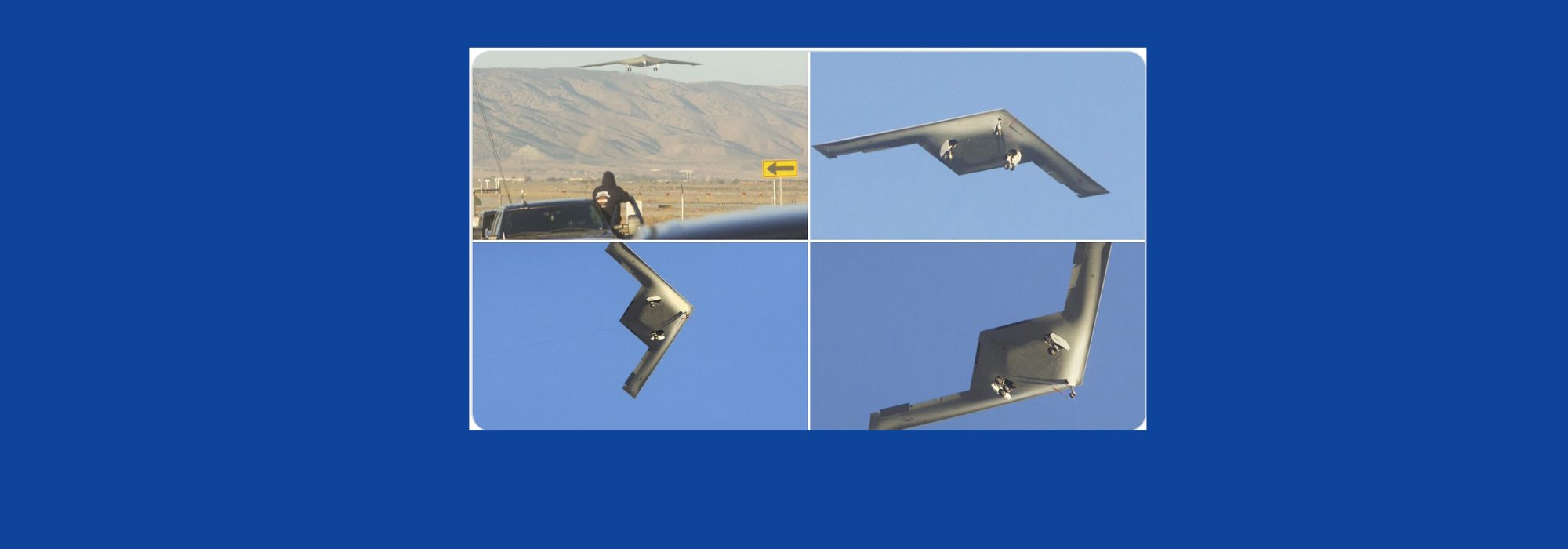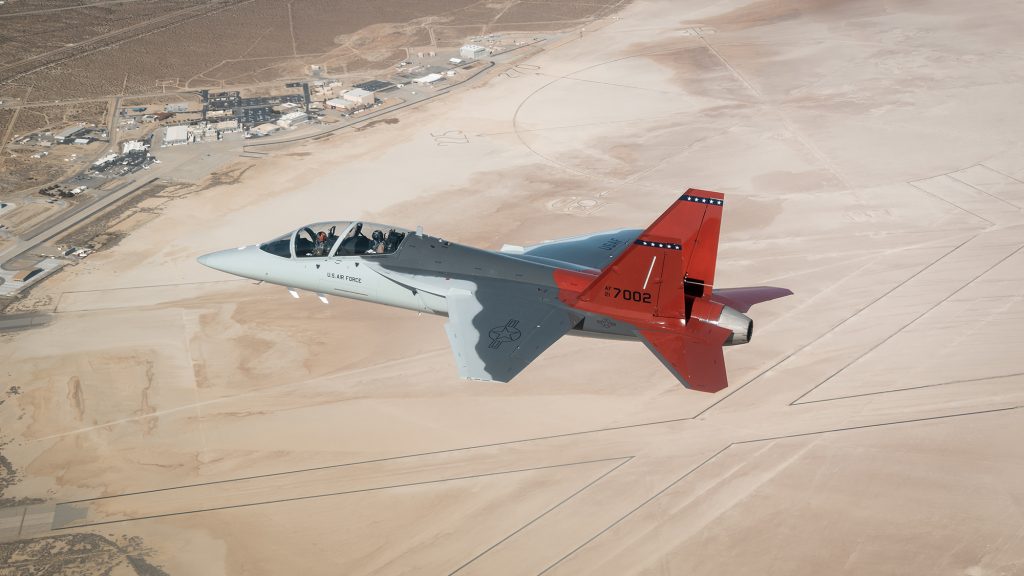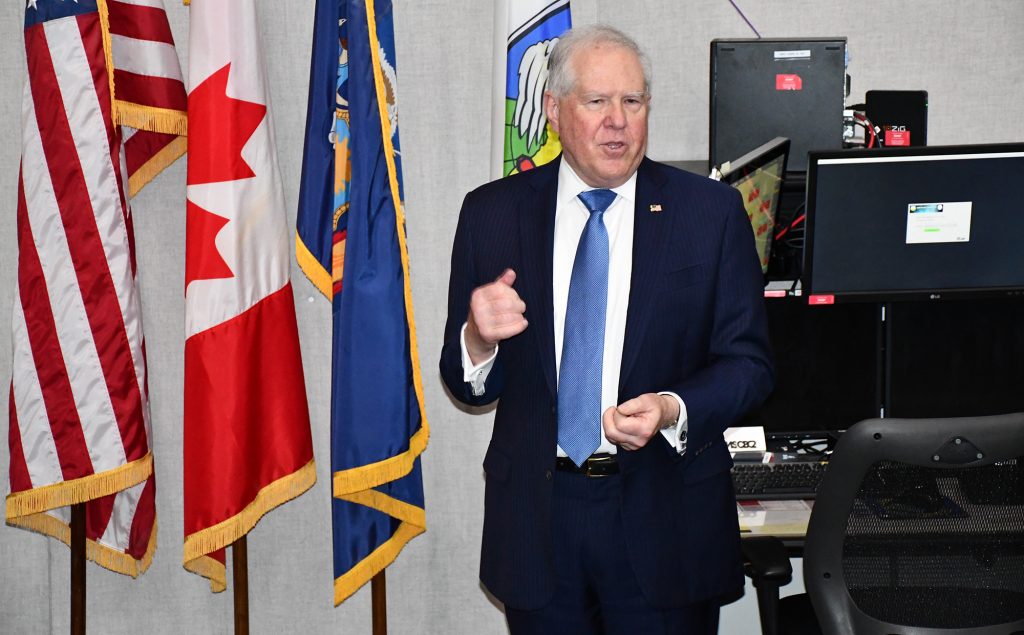1st Flight of the B-21 Raider
By John A. Tirpak
The first B-21 Raider bomber took off from Air Force Plant 42 in Palmdale, Calif., just after dawn on Nov. 10, en route to Edwards Air Force Base, Calif. That first 90-minute flight, decades in the making, paves the way for months of testing.
Plane spotters filmed the aircraft from near Plant 42, heading eastbound with an F-16 chase plane after climbing to about 500 feet. The landing gear had yet to be retracted in video and photos that appeared on social media, and a lengthy cable appeared to be trailing from the upper surface of the tail on the port side, near the exhausts.
An Air Force spokesperson confirmed the plane took off at approximately 7 a.m. local time and landed safely at Edwards about 8:30 a.m., fulfilling promises by manufacturer Northrop Grumman and the Air Force that the new stealth bomber would fly before the end of 2023.
The duration of the flight suggests that pilots did more than a ferry hop to Edwards and that they likely conducted tests to evaluate flying qualities. Flight-tracking websites indicated a roundabout pattern between Palmdale and Edwards. The flight was not announced beforehand.
“As confirmed by the U.S. Air Force, the B-21 Raider is in flight-test,” a Northrop Grumman spokesperson said. “The robust flight test campaign is being executed by a Combined Test Force comprised of Northrop Grumman and Air Force personnel that will validate our digital models and moves us another step closer to reaching operational capability.”
An Air Force spokesperson said flight-testing “is a critical first step in the test campaign managed by the Air Force Test Center and 412th Test Wing’s B-21 Combined Test Force to provide survivable, long-range penetrating strike capabilities to deter aggression and strategic attacks against the United States, allies, and partners.”
The first operational B-21s will be based at Ellsworth Air Force Base, S.D. Maintenance will be managed at Tinker Air Force Base, Okla.
Six test aircraft are being produced now, all on the same production line, using the tools, processes, and technicians that will be used for production aircraft.
The Air Force has previously said that B-21 test aircraft will be “usable assets” as soon as they are airworthy, and that the test aircraft will be converted to the operational configuration after developmental and operational testing is complete.
The contract for the B-21, originally called the Long-Range Strike Bomber, was awarded in 2015, and the aircraft is expected to cost around $700 million each in current dollars.
The B-21 was officially named the “Raider” in 2016, to honor the Doolittle Raiders of World War II that carried out the first airstrikes against Japan.
Northrop Grumman President and Chief Executive Officer Kathy Warden has acknowledged that, due to the fixed-price nature of the program, inflation, and labor costs in recent years, the company will earn “zero” profit on the initial production contract. However, the company has said it expects to receive a $60 million adjustment from the Air Force to mitigate those additional expenses.
New Features Emerge
Plane spotter photos taken during runway taxi tests show vertical features that left many industry observers curious. A photo posted on Reddit by user “Folding_White Table” showed two vertical armatures rise from just above the wing root of the blended wing body on both the port and starboard sides, just above where the engine core or cores are likely placed. It’s unclear from the photo whether they are symmetrically positioned on the aircraft.
Based on previous photos, the vertical features seem to be retractable.
At least one of the armatures was visible in an earlier, first view of the B-21’s aft deck, which circulated online in October. However, the angle of that photo made it hard to determine whether it was part of the aircraft or a background object.
In a Reddit post, u/Folding_White Table said the photos were taken from the intersection of 40th Avenue East and Avenue N in Palmdale, right at the fence line of Northrop Grumman’s end of Air Force Plant 42. The photographer said the spot offers a “perfect view of runway 25/7, 22/4 and Site 4,” on the closest public road to Northrop’s facilities.
Some industry experts speaking on background, given the sensitive nature of the B-21, suggested the vertical armatures could be coverings for auxiliary air intakes in the open position, and may be extended to allow more air into the engines for ground operations. But others disputed that theory, suggesting the armatures may be too far back and too slender to serve that purpose efficiently. One also noted that the armatures are “unusually tall” for such a purpose and so thin that the opening they putatively cover might not be big enough to supply the necessary air.
The verticals also appear to be triangular and pylon-shaped, rather than flat. But experts discounted the idea that the verticals could be antennas or sensors, as they would ruin the B-21’s stealthy shape if extended during an operational mission, and not positioned correctly for them to be fuel vents, which are typically positioned at the aircraft’s tail.
One possibility: The features are there simply to disrupt a ground-based sensor from learning too much about the B-21’s radar cross-section. The stealthy F-117 and F-35 both have a removable, faceted device that makes them more visible to air traffic controllers and increases their radar cross-section, but that can be removed for combat operations.
On the B-2, which was manifestly the design basis for the B-21, the auxiliary air intakes are set just above and aft of the intake and give the appearance of four curved paddles, with two above each intake.
The B-21’s vertical armatures are also near—but outboard of—an unexplained dark feature on the surface of the aircraft on both sides of the central hump or spine. This feature is also visible in the forward-quarter of an image of the aircraft released by the Air Force. It is inboard of the engine inlets in that image—not in line with them—on the side of the spine.
One expert suggested the dark feature is a mechanism to disperse the large quantity of heat likely generated by the B-21’s avionic; another speculated that it could be a bleed air vent necessitated by the B-21’s serpentine inlets—the air tunnels that conceal the engine fan blades.
Tests Finally Begin for T-7A Red Hawk
By David Roza
The first T-7A Red Hawk landed at Edwards Air Force Base, Calif., on Nov. 8, marking the start of developmental flight tests for the two-seat jet. The T-7A is the planned replacement for the T-38 trainer for fighter and bomber pilots.
Designated APT 2, the Boeing jet was the first production representative T-7 to be built, and the same aircraft that Maj. Bryce Turner flew on June 28, in the first official test flight by an Air Force pilot. A joint Boeing and Air Force crew flew the jet from the Boeing facilities at St. Louis to Vance Air Force Base, Okla., Kirtland Air Force Base, N.M., and Luke Air Force Base, Ariz., before finally arriving at Edwards.
“This arrival marks an exciting transition into the next phase of developmental flight,” said Maj. Jonathan “Gremlin” Aronoff, T-7A test pilot, in an Air Force release. “The T-7A gives immense capability updates that will allow the Air Force to train the next generation of combat aviators. Success of first delivery is truly a testament to the joint USAF-industry team we have in place.”
The aircraft was piloted by Aronoff and Boeing test pilot Steve “Bull” Schmidt.
The goal of developmental flight testing is to evaluate changes made earlier in the development process and determine how and whether to refine the aircraft further. Boeing and Air Force officials told reporters in September that another T-7 designated APT 1 will join APT 2 at Edwards while APT 3 will undergo weather testing at the McKinley Climatic Laboratory at Eglin Air Force Base, Fla., before being used as a mission systems testing platform. APT 4 and 5 are due later this year.
According to the press release, test pilots have been rehearsing missions in a simulator and will now start flying up to three times a day as they try expanding APT-2’s flight envelope—the maximum altitude and airspeed in certain conditions—before testing mission systems.
The Air Force needs the T-7 to replace the 1960s-era T-38 fleet, which is increasingly difficult to maintain. The Red Hawk was originally due to reach initial operational capacity in 2024, but has been held up by problems with flight stability, flight control software, and its ejection seats.
The Air Force has been cagey about other uses for the Red Hawk, which could also be adapted to become a light fighter once properly equipped.
NORAD Puts C2 in the Cloud
By Chris Gordon
The U.S. is modernizing its air defenses with a new Cloud-Based Command and Control (CBC2) system that came online last month.
The Eastern Air Defense Sector, one of NORAD’s regional commands, reported its initial operating capability of CBC2 uses of artificial intelligence to help personnel monitor more information more simply.
“Instead of an air battle manager having to consult different screens or systems for different sensor inputs or data, CBC2 brings together those inputs,” a North American Aerospace Defense Command official explained to Air & Space Forces Magazine. “The effect is a more streamlined connection between sensors, systems, and decision-makers.”
The advance marks a “pivotal milestone in the service’s modernization of tactical command and control capabilities,” NORAD said.
The new system is part of the Air Force’s push toward greater connectivity as part of the Advanced Battle Management System (ABMS). The Air Force plans to expand CBC2 to the Pacific and other locations, using a model known as agile development, security, and operations (DevSecOps)—software that will continually receive updates.
NORAD and U.S. Northern Command, which is responsible for the defense of North America, are the first to receive the capability. Starting with EADS, which covers the eastern United States, is a priority because the region includes Washington, D.C.
“We didn’t do an overall CBC2 contract and hand it off to somebody that kind of did all the typical integration kinds of things,” Brig. Gen. Luke C.G. Cropsey, who is in charge of the Department of the Air Force’s ambitious ABMS efforts, said at AFA’s Air, Space & Cyber Conference in September. “We actually went directly to the experts in their respective layer of the stack, and we said, ‘Hey, who’s the best at ‘fill in the blank,’ and we went and we got them on contract.”
CBC2 will aggregate and integrate military and commercial air defense data sources into one common picture to support homeland defense, the service says.
EADS headquarters is located at Griffiss Business and Technology Park in Rome, N.Y., and is largely staffed by the Air National Guard. Despite its nondescript location, the rollout was attended by senior military officials, including Secretary of the Air Force Frank Kendall, Cropsey, and high-level representatives from the Royal Canadian Air Force, the Office of the Secretary of Defense, and USAF Lt. Gen. Dagvin R.M. Anderson the Joint Staff Director for Force Development (J7).
“Advancing our command and control capabilities is instrumental in achieving the department’s Second Operational imperative—achieving operationally optimized Advanced Battle Management Systems—while maintaining technological superiority in a rapidly evolving threat landscape,” Kendall said in remarks at the ceremony.
CBC2 is a multinational effort. “CBC2 incorporates a large number of tactically relevant data feeds as well as artificial intelligence and machine learning to assist decision makers with maintaining detailed situational awareness of the battlespace,” EADS said in its news release. “The platform uses this data to develop courses of action from which leaders can make higher quality and faster decisions that improve operational outcomes.”
Next to get CBC2 will be the Canadian Air Defense Sector (CADS), which is expected to field the new technology by mid-2024. NORAD expects to roll out CBC2 to the air defense sectors in Alaska, Hawaii, and Washington throughout 2024.
“NORAD will apply CBC2 in our air defense sectors to modernize air battle management software interfaces,” the official from the command said.
CBC2 is expected to be upgraded to fit in with hardware updates as they are fielded, such as NORAD’s planned new over-the-horizon radar, the NORAD official said.
“We’re deploying capability starting now,” Cropsey said in September. “It will obviously continue to happen in the future. But this isn’t something that’s five years away. This is today.”


